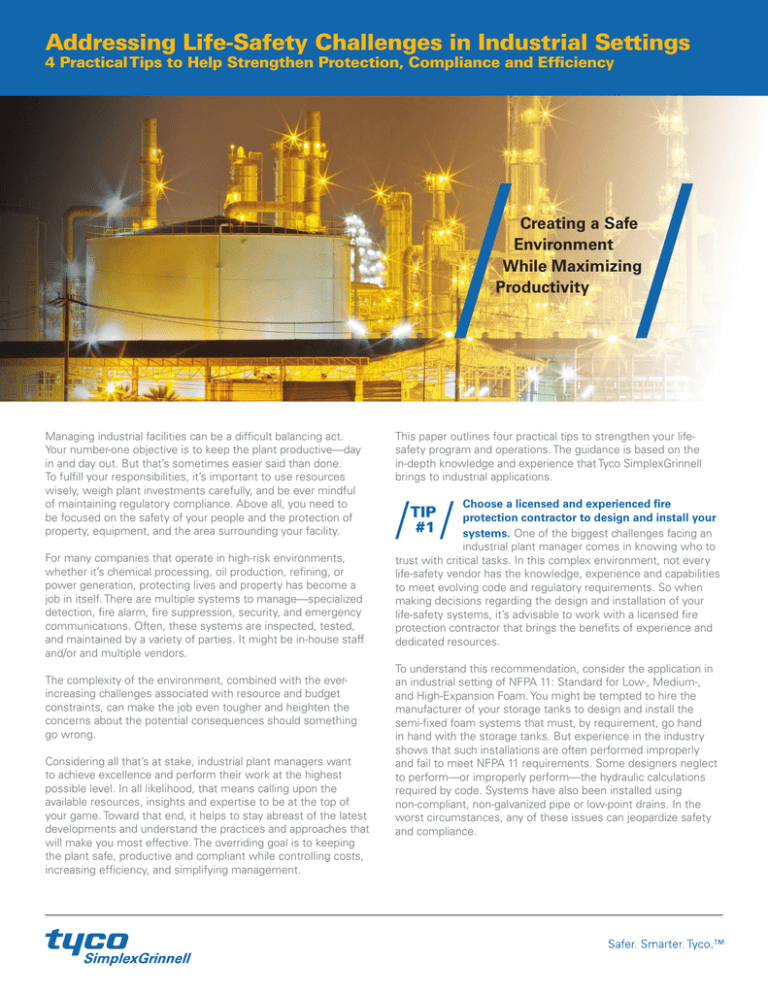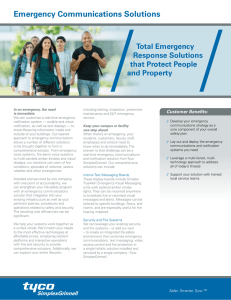
Addressing Life-Safety Challenges in Industrial Settings
4 Practical Tips to Help Strengthen Protection, Compliance and Efficiency
Creating a Safe
Environment
While Maximizing
Productivity
Managing industrial facilities can be a difficult balancing act.
Your number-one objective is to keep the plant productive—day
in and day out. But that’s sometimes easier said than done.
To fulfill your responsibilities, it’s important to use resources
wisely, weigh plant investments carefully, and be ever mindful
of maintaining regulatory compliance. Above all, you need to
be focused on the safety of your people and the protection of
property, equipment, and the area surrounding your facility.
For many companies that operate in high-risk environments,
whether it’s chemical processing, oil production, refining, or
power generation, protecting lives and property has become a
job in itself. There are multiple systems to manage—specialized
detection, fire alarm, fire suppression, security, and emergency
communications. Often, these systems are inspected, tested,
and maintained by a variety of parties. It might be in-house staff
and/or and multiple vendors.
The complexity of the environment, combined with the everincreasing challenges associated with resource and budget
constraints, can make the job even tougher and heighten the
concerns about the potential consequences should something
go wrong.
Considering all that’s at stake, industrial plant managers want
to achieve excellence and perform their work at the highest
possible level. In all likelihood, that means calling upon the
available resources, insights and expertise to be at the top of
your game. Toward that end, it helps to stay abreast of the latest
developments and understand the practices and approaches that
will make you most effective. The overriding goal is to keeping
the plant safe, productive and compliant while controlling costs,
increasing efficiency, and simplifying management.
This paper outlines four practical tips to strengthen your lifesafety program and operations. The guidance is based on the
in-depth knowledge and experience that Tyco SimplexGrinnell
brings to industrial applications.
Choose a licensed and experienced fire
protection contractor to design and install your
systems. One of the biggest challenges facing an
industrial plant manager comes in knowing who to
trust with critical tasks. In this complex environment, not every
life-safety vendor has the knowledge, experience and capabilities
to meet evolving code and regulatory requirements. So when
making decisions regarding the design and installation of your
life-safety systems, it’s advisable to work with a licensed fire
protection contractor that brings the benefits of experience and
dedicated resources.
TIP
#1
To understand this recommendation, consider the application in
an industrial setting of NFPA 11: Standard for Low-, Medium-,
and High-Expansion Foam. You might be tempted to hire the
manufacturer of your storage tanks to design and install the
semi-fixed foam systems that must, by requirement, go hand
in hand with the storage tanks. But experience in the industry
shows that such installations are often performed improperly
and fail to meet NFPA 11 requirements. Some designers neglect
to perform—or improperly perform—the hydraulic calculations
required by code. Systems have also been installed using
non-compliant, non-galvanized pipe or low-point drains. In the
worst circumstances, any of these issues can jeopardize safety
and compliance.
Another practice that occurs commonly in
the industry involves the use of standard
ground monitors instead of foam chambers
on the semi-fixed foam systems. While
ground monitors are fine for putting foam
in trenches around a tank or for providing
additional support to a foam chamber
system, they are not an efficient primary
method for blanketing the tank itself.
Let’s look for a moment at private fire
service mains. When non-fire protection
contractors install private fire service
mains, there can be violations of NFPA 24:
Standard for the Installation of Private Fire
Service Mains and Their Appurtenances.
For example, some use noncompliant pipe instead of the
required welded carbon steel pipe. If corrosion subsequently
builds up within the pipe, it can clog nozzle heads or other critical
valves, potentially causing a system failure.
None of these code violations or deficiencies would be obvious
or noticeable to the untrained eye. And any one of them could
potentially shut down your plant temporarily or, in the worst-case
scenario, put lives and property at risk. That’s why the applicable
codes specifically require the use of licensed fire protection
companies to design and install fire systems.
To help your facility meet the highest standards of safety,
consider working with a life-safety provider that requires all
installation personnel to pass an intensive apprenticeship
program and get individually licensed by the state before
becoming full-fledged installers. These same individuals can
serve you better when they receive ongoing training to stay
abreast of code changes.
Put all these factors together, and they paint a clear picture of
how the selection of a licensed and experienced fire protection
contractor to design and install your fire systems can support
your efforts to enhance protection, maintain regulatory
compliance, and gain greater peace of mind.
Engage a licensed service provider with
NICET-certified personnel to test, inspect,
and maintain fire systems. Intuitively, it may
seem like a cost-effective and sensible idea for
an industrial company to have in-house personnel handle fire
system inspection, testing, and maintenance. After all, the
reasoning goes, many of the tasks involved appear to be fairly
straightforward and manageable.
TIP
#2
In fact, the “do-it-yourself” approach, while common in industrial
facilities, may not the best way to handle system service. And
there are a number of reasons for that. Most states require
licensed personnel to perform the work. Some even require
NICET certification. Licensed inspectors can add significant value
by bringing a critical level of experience to the process. Their
contributions and support should be viewed from that value
perspective, rather than on a cost basis. Using their experience
and ongoing training on code changes, licensed inspectors are
capable of spotting potential violations and risks before disaster
strikes, a shutdown is ordered, or costs escalate. When issues
are identified earlier, they can usually be remedied more easily
and cost effectively—and with less disruption to your operations.
Questions involving conflict of interest and time management
can also emerge in deciding whether to handle service in-house
or contract with an outside provider. Will an employee doing
an inspection be reluctant to flag a problem if it might have a
negative financial or operational impact on the company? What
if an in-house inspector overlooks an issue because it might
require more difficult work for the maintenance department? If the
inspecting employee has other production responsibilities, is there
a risk that fire systems will be neglected for higher-priority work?
Cost savings and liability should also be carefully weighed. The
cost savings associated with in-house inspection, testing, and
maintenance can be outweighed by potential liability the company
could face in the event of a failure. In a high-risk industrial setting,
there could be devastating financial implications, not to mention
the negative impact from adverse publicity.
These challenges and issues can be overcome by enlisting the
services of a licensed provider with experienced, NICET-certified
personnel. The right service provider can help you maintain the
highest standards and keep your facility well protected and code
compliant.
Use the right system to control and monitor
fire and life-safety functions and operations.
NFPA 72: National Fire Alarm and Signaling Code
mandates specific requirements for configuration,
installation and survivability of fire systems. Some industrial
companies have been known to use Programmable Logic
Controllers (PLCs)—and their related Distributed Control
Systems (DCS)—to control and monitor fire systems. PLCs and
Distributed Control Systems play important roles in industrial
facilities, but are not appropriate for this purpose. In fact, it is a
code violation to use them in that way.
TIP
#3
Secondly, NFPA standards require parts
and components to be UL Listed—
individually and in how they work
together. For example, solenoid valves in
a fire system have to be listed with the
panel controlling them. This is intended to
ensure that critical components perform
as designed in an emergency. If those
components are controlled by a different
system—one not expressly designed for
fire protection—there is no assurance
they will function smoothly together.
Nor is it certain that they will perform
appropriately in adverse conditions such
as extreme heat or when water from
sprinkler/deluge activation is present.
In addition to these considerations, there’s another very
pragmatic reason for having a dedicated system to control and
monitoring fire protection operations and activities. It enables
you to test, maintain, and repair life-safety systems without
impeding or disrupting the DCS-controlled production systems
that are essential to uptime, productivity, and profitability. A DCS
can be connected to fire systems to monitor information in a
control room and help management make critical decisions, but it
should never be used to control these systems.
Capitalize on the benefits of using a singlesource life-safety service provider. The industrial
community is served by a broad range of lifesafety vendors, many of whom specialize in
particular products or services related to fire alarms, sprinklers,
fire suppression, gas detection, emergency communications,
integrated security, and special hazards. Entrusting responsibility
for the upkeep and repair of each of these areas to a different
vendor may appear sensible—after all, why put all your eggs in
one basket?
TIP
#4
However, there can be several major disadvantages to doing so.
That approach can leave you with multiple vendors to manage,
multiple contracts with different terms and conditions, and no
single point of contact in an emergency.
If a problem arises that affects several systems maintained by
different vendors, will there be finger-pointing? Can any vendor
be fully accountable if their responsibilities only go so far?
For example, let’s say an industrial company uses one vendor for
the fire alarm system and another for sprinkler systems. With a
pre-action system, the fire panel controls the sprinkler system.
So who is ultimately responsible for the overall performance
across multiple systems? Furthermore, scheduling, coordinating,
and overseeing multiple inspections by multiple vendors can be a
time-consuming hassle.
A better course of action is to build a single-source relationship
with a primary life-safety company that can assume responsibility
for the upkeep of all systems and equipment—even those from
other vendors. Besides relieving you of the task of coordinating
inspections, tests, and maintenance, this approach can bring
the advantages of working more closely and collaboratively with
a company whose life-safety capabilities are broad and wide
ranging. Together, you can take a more comprehensive view of
your life-safety needs and determine to best fulfill them and keep
your facility compliant.
The Bottom Line: Strengthening Your Life-safety Program
Given the significance of the responsibilities held by those
responsible for life safety in industrial facilities, you definitely
don’t want to go it alone. It makes sense to look for every
opportunity to ease your burden while keeping your facility safe
and compliant.
The tips outlined in this paper are offered to help simplify your
life, minimize disruption, and enable you to focus on what
matters most: a safe, secure environment, maximum efficiency
and uptime, and a healthy bottom line.
Corporate Sales and Marketing
50 Technology Drive • Westminster, MA 01441-0001
Tel: (978) 731-2500 • Toll Free: 1-800-746-7539
© 2014 SimplexGrinnell LP. All rights reserved. TYCO, SIMPLEX, SIMPLEXGRINNELL, and the product names
listed in this document are marks and/or registered marks. Unauthorized use is strictly prohibited.
License numbers available at www.tycosimplexgrinnell.com or contact your local Tyco SimplexGrinnell office.
Printed in USA
10%
Cert no. SW-COC-001530
www.tycosimplexgrinnell.com
MC140-2014-001
0614



